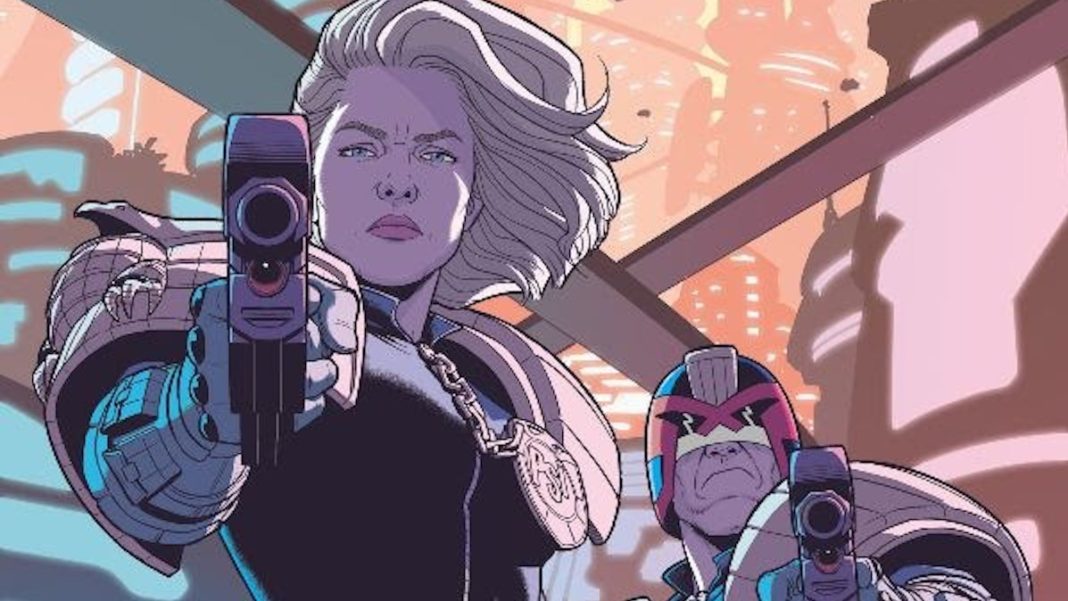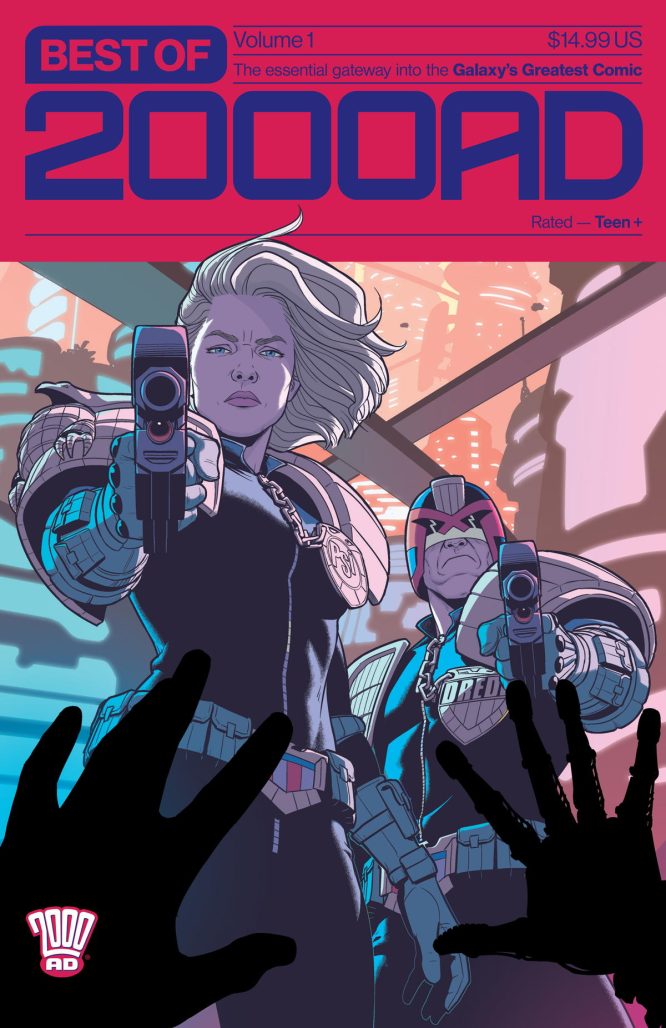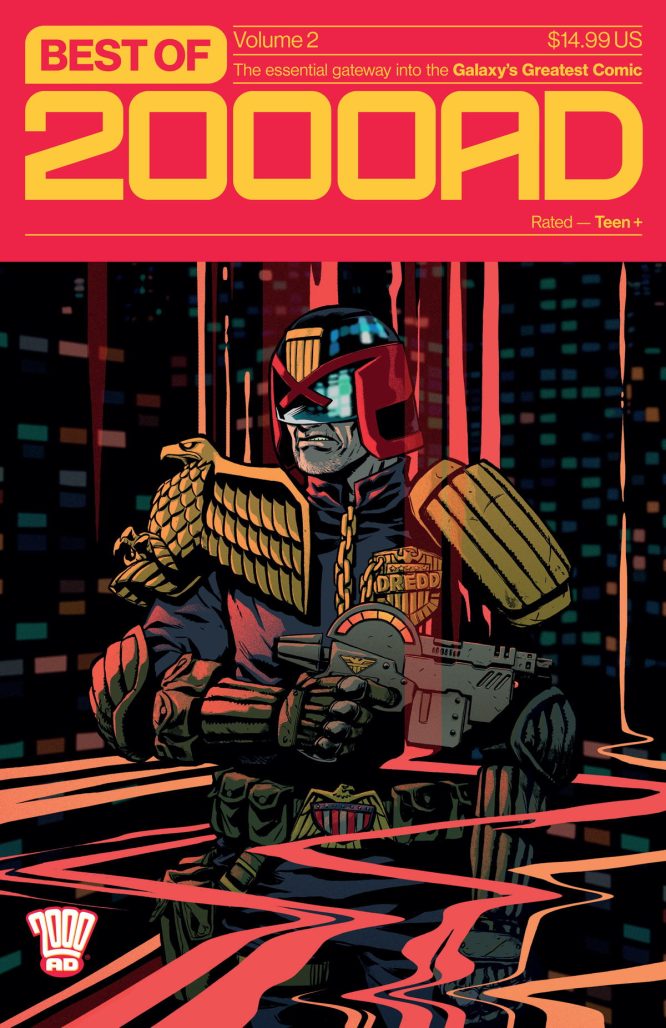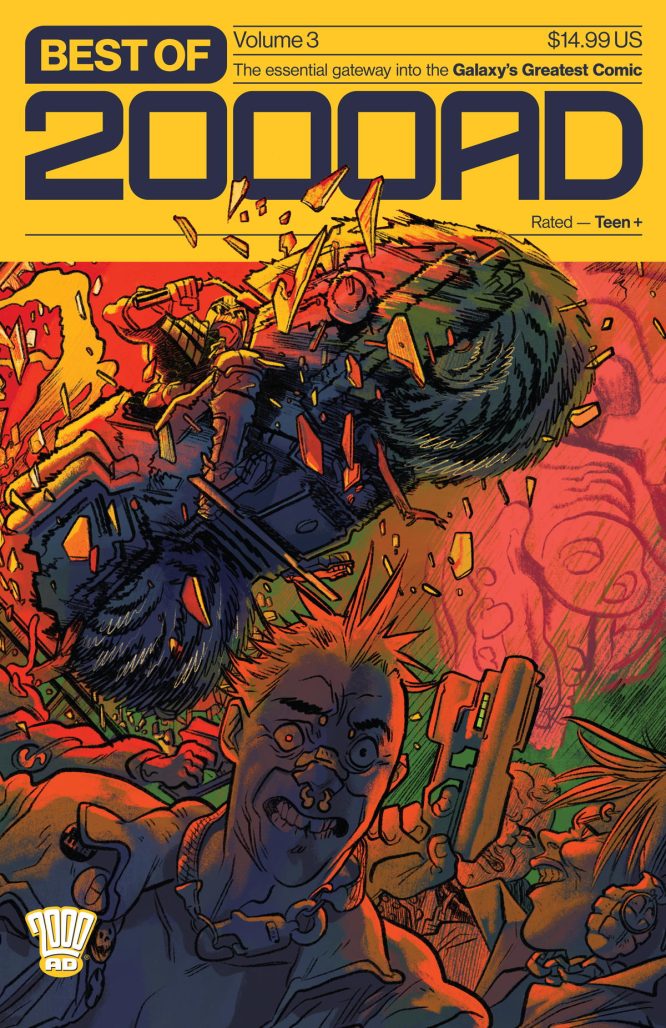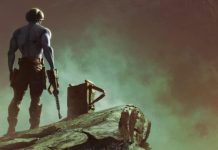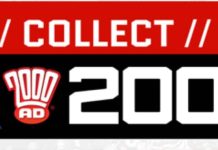Two-hundred-page trades, six planned volumes, and a packed roster of choice cuts: the Best of 2000 AD series hopes to draw in new readers and fans to the self-proclaimed Galaxy’s Greatest Comic in its 45th year of existence with glimpses of its wide archive of material (and a heady mix of thrill-power).
As the first volume hits store shelves, Stately Beat Manor’s own Squaxx dek Thargo Dean Simons chats with editor Owen Johnson about the intimidating task of compiling a mixtape of thrills to attract readers beyond the UK home of the weekly anthology.
Dean Simons: The first version of Best of 2000 AD ran for 119 issues in the UK between 1985 to 1995. Had you been a reader of the original? Why bring it back and what makes this one different (besides the 27 years of newer classics)?
Owen Johnson: I was vaguely familiar but wasn’t a reader. My entry point was via graphic novel reprints by Titan Books, but it was casual. My first work for Rebellion directing the 40th Anniversary of 2000 AD Festival back in 2017 was a Big Bang moment when seeing how dedicated and passionate the fan base is, and how unique it is.
I have since discovered those Best of 2000 AD issues, and I was familiar with the Eagle reprints including the stunning covers (like Brian Bolland’s) which I used as examples to brief our new cover artists, hoping to create iconic pop images that stand alone as single-image story moments.
With every long-running book or characters, it’s crucial to keep reaching out to fresh readers and new markets as they open up; adapting how you engage with a changing world. There have been a number of reincarnations away from the newsstand original, and now Rebellion has this wealth of graphic novel versions available in the book trade.
The Best of 2000 AD series is an extension of that, and a different beast to what’s come before. But it felt important to tip our hat with the title to what came before. You’re part of a legacy.
DS: Who is the new Best of 2000 AD for? Are you predominantly going for US readers?
OJ: The US and Canada is where most new readers are so they are the focus in that territory, which means creating a book that works in that context. Hiring known US cover artists is a huge part of that. Tom Muller’s design was also critical in placing it in a contemporary landscape of the fine genre publishers native to the US.
The UK fans remain our lifeblood and have been loyal for decades. We’re lucky to have them. So the book functions as a ‘Greatest Hits’ for them and hopefully a reminder of why they loved this stuff in the first place.
DS: This project was originally announced in late 2019 as a 12-issue monthly, what happened to necessitate this shift in format, rather than just delaying the monthly? Did it alter much in the shift?
OJ: It began in that format because we believe passionately in bricks-and-mortar comic stores and the people who run them. We wanted to give them an exclusive product for customers who asked “where do I start with 2000 AD?”. This was the impetus behind the entire project (I’d spent three years at ALA, ComicsPro, and various Diamond retailer summits and listened to feedback from retailers, librarians, and people who sell our books).
We were set to launch on the eve of the pandemic which wiped out international shipping and exposed the weak beams in the direct market. Being a British publisher shipping into the US has always proved challenging but this was unprecedented for everyone.
Content-wise, Covid shifted everyone’s perspective and, in hindsight, we were probably limiting ourselves unnecessarily. We had already planned on an edition of Best of 2000 AD for the book trade, but a 100-page ‘bumper issue’ wasn’t the perfect fit that a 200-page heavy stock cover with spot UV is.
When deciding to make a book trade product you’re looking at readers who may be very different kinds of comic reader. So we went back to the content and filtered out anything that needed prior knowledge or continuity ties. Every comic is someone’s first comic, and accessibility became the primary drive for everything. We just doubled down on that because if you enjoy this then the other stuff is waiting for you.
DS: How do you figure now is a good time for the relaunch?
OJ: Because it remains a sound concept, a killer book, and we really believe that it’s a wonderful representation of 2000 AD, how special it is, and how a hand reaching out to show you a cool new thing is always exciting. Also, people have been stuck in their houses reading more than they ever have before.
DS: Does a trade paperback edition become easier to sell and distribute via the book market over comics distributors?
OJ: We’re certainly not choosing book trade over comic distributors, it’s a case of using both to their own advantage. Both come with challenges.
There’s far more bleed between direct market and book trade than ever before, from distribution right down to hybrid stores, even with shipping challenges release days can vary. Adaptability, flexibility, and options are important to everyone. It just felt right to open up the ambition and the potential channels for success.
Being distributed with Simon & Schuster, we can fulfill orders and re-orders much quicker, and lessen the impact of the biggest single obstacle which is international shipping. And we also get the marketing benefits and the link directly to US stores through Diamond.
It’s all about getting as many eyes on the book as possible. It takes as much effort to market and increase awareness in both arenas.
DS: What will the launch frequency be? Will it remain, as previously indicated, quarterly? Has the publishing landscape become more predictable at this point of the pandemic?
OJ: Quarterly is the plan, for as long as it publishes. There is still nothing predictable about the publishing landscape, it seems. Which is why pre-order and subscriptions are more important than ever.
DS: How do you select representative stories more likely to attract a modern (presumably US) target audience for the books? What do you base your decisions on?
OJ: There are creators known to US audiences through other work. Alan Moore, John Wagner, Al Ewing, Dan Abnett.
In terms of art, you look for that X factor that is so graphically appealing and iconic that even if it’s classic it projects forward and still feels modern. It’s hard to define but Mick McMahon, Jamie Hewlett, Kevin O’Neill’s color work on Nemesis come to mind. INJ Culbard’s art feels as timeless as Ian Gibson’s when you press them together.
That’s the joy of the anthology format. You can’t shy away from that, it’s 2000 AD. That’s the strength of it. The mix is alchemy. It can be dark and intense, there’s a satirical bite but it can be silly, playful stuff, and often un-cynical and heartfelt. It’s so broad, and being reflective of that in a way that connects is the trick.
DS: Do you have personal favourite classic strips?
OJ: The dark, weird stuff so Nemesis and Leviathan. Halo Jones remains a comic masterpiece. As Comics Beat alumnus Adam Karenina Sherif writes in his essay Shamballa by Arthur Ranson and the late great Alan Grant should stand alongside Watchmen and The Dark Knight Returns.
We get to showcase Dredd artist Ron Smith later on; to me he’s a vastly underrated Dredd artist. His sense of world-building and craft added so much to conceptualising Dredd’s world.
DS: Six volumes in the series have been announced. Is there a chance it will be extended? Is there a theme for each volume?
OJ: It all depends on sales. We’ve made a phenomenal start, selling out of the first print run two weeks before publication and gone straight to a reprint. It’s been designed to back-list well and act as a gateway into our entire back catalogue. More importantly, thanks to marketing’s efforts and the amazing influencers we’ve shown the book to, it has seemed to attract the brand-new audience we were hoping for.
But we’ll have to see if that’s maintained as the series continues, and if we can pick up new readers along the way. Launching one graphic novel in this market is a miracle, a whole series is a huge long-term investment. We need each and every reader to make that pay off.
DS: The decision to include critical essays to complement the material is very interesting. How did that come about and how do you choose the right person(s) for the job?
OJ: It just felt natural, and important to have modern voices explore these stories. Comics criticism is in a golden age and these are valuable creatives in their own right, with their own audiences, who can bring even more eyes on this classic work. It’s important to reach out to comics readers who may be strangers and prove why these stories are still vital and relevant, can matter to them and can reflect the world we live in now.
It was also natural to include in a book market used to prose introductions and coffee-table publications you can dip in and out of.
DS: Getting the ‘mix-tape’ right. What lay behind each pick and how do you think each best reflects the history of the Prog, and acts as a balanced opening salvo for the Best of 2000AD project?
Volume 1 contains:
|
OJ: It all comes down to the mission statement we set ourselves: can you read it if you know nothing prior? Is it satisfying as a ‘track’ or story on its own, with no sense of continuity (harder than it looks)? Is the volume satisfying as a ‘complete meal’ without reading the one before/after?
We decided on a template and stuck to it: modern Dredd, deep cuts and hidden gems, feature presentation, vintage Dredd. With each Dredd to try to shine a light on another corner of that world. Entering Mega City One with mutants in Mutie Block felt a great way of introducing him.
Where possible, some volumes have a theme. There’s a very ‘POP’ volume. There’s a ‘WEIRD’ volume. There’s a loose Cursed Earth volume late in the schedule. But we tried to keep it organic. I think we subliminally programmed the first volume with Halo Jones, Brink, and Shamballa to subvert a prejudice that the comic has always featured action-hero male protagonists.
HQ is full of vastly more knowledgeable staff than I, in this instance editors Matt Smith and Oliver Pickles and 2000 AD brand manager Michael Molcher suggested incredible work I’d have overlooked. I also consulted with some trusted friends who ranged from comics readers new to 2000 AD as well as deep lore masters. You listen to everyone’s opinion and then decide for yourself. Of course, even curating classic material you bring bias and accept you can’t please everyone.
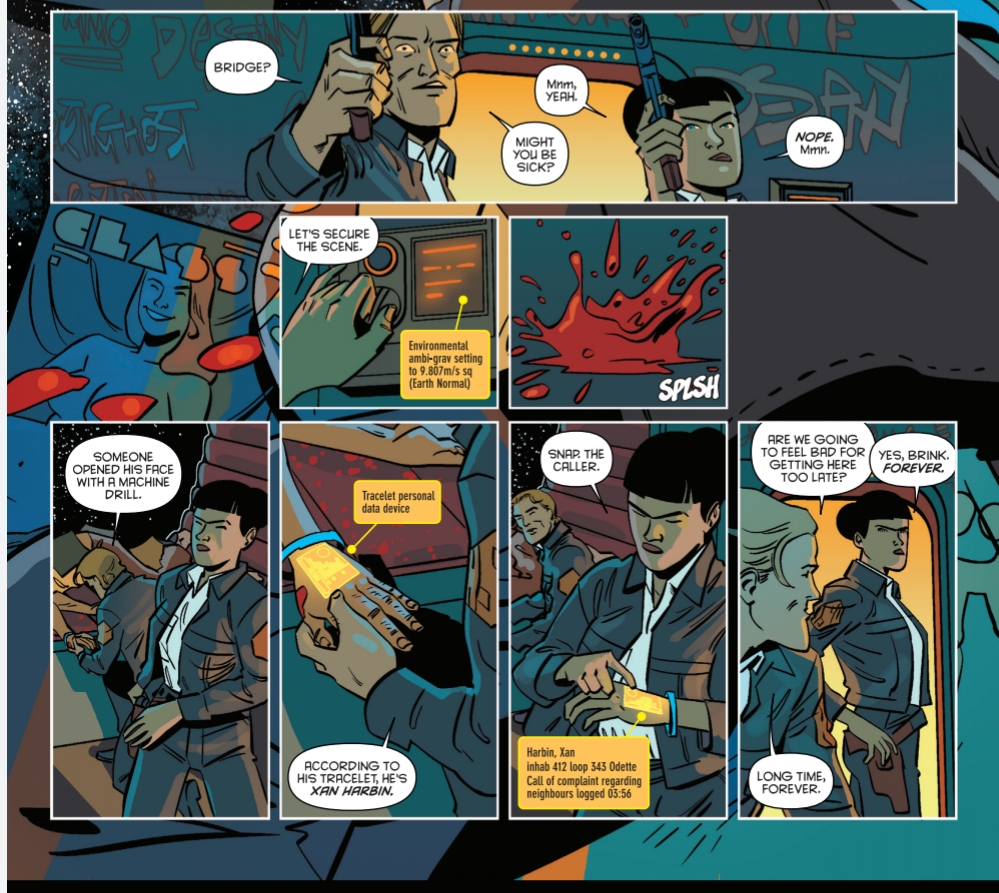
DS: I notice all the stories are in colour but a significant amount of the old classics catalogue (and the classical high points of the Prog) pre-dated colour. Will there be much of the black-and-white catalogue upcoming? Do you think they are a harder sell for modern readers?
OJ: Not a harder sell, as the popularity of manga has proved. But this was always intended as a primarily full-colour book.
To avoid the jarring effect of flipping between colour and black and white material there will be a colour treatment on all archive comics originally in black and white. This makes it a smoother read and also adds to the long-box diving nostalgia of the whole thing. There’s an opportunity with our fantastic design and reprographics team to make these true tactile, unique artifacts. Let’s have fun!
It was also important to separate from the versions of this material published before. I’m a firm believer in adding new value with each publishing iteration and this felt right with the ‘remix’ ethos of the project. [laughs] Perhaps sacrilege to some but hopefully people agree it makes it pop in context.
DS: What can you tease will be upcoming in future volumes? Are stories from the Judge Dredd Megazine monthly sister title likely to make an appearance?
OJ: Book one of Nemesis The Warlock is awesome. It’s hugely exciting to reprint Leviathan which has been out of print for a long time, as well as including Missionary Man by The World’s Greatest Living Comic Artist™ Frank Quitely. Each volume really is an embarrassment of riches packed with the best comics that have ever been published in the West. But inevitably you’ll have to leave out a stunner. So let’s go digging again!
The Best of 2000 AD, Volume 1 is out now from all good comic shops, bookstores, and thrill merchants. Volume 2 is scheduled for January 2023.


